YAMAHA TRICITY 2016 User Guide
Manufacturer: YAMAHA, Model Year: 2016, Model line: TRICITY, Model: YAMAHA TRICITY 2016Pages: 87, PDF Size: 2.59 MB
Page 11 of 87

Safety information
1-4
1
able only from a Yamaha dealer, have
been designed, tested, and approved
by Yamaha for use on your vehicle.
Many companies with no connection
to Yamaha manufacture parts and ac-
cessories or offer other modifications
for Yamaha vehicles. Yamaha is not in
a position to test the products that
these aftermarket companies produce.
Therefore, Yamaha can neither en-
dorse nor recommend the use of ac-
cessories not sold by Yamaha or
modifications not specifically recom-
mended by Yamaha, even if sold and
installed by a Yamaha dealer.
Aftermarket Parts, Accessories, an
d
Mo difications
While you may find aftermarket prod-
ucts similar in design and quality to
genuine Yamaha accessories, recog-
nize that some aftermarket accesso-
ries or modifications are not suitable
because of potential safety hazards to
you or others. Installing aftermarket
products or having other modifications
performed to your vehicle that change
any of the vehicle’s design or operation
characteristics can put you and others at greater risk of serious injury or
death. You are responsible for injuries
related to changes in the vehicle.
Keep the following guidelines in mind,
as well as those provided under “Load-
ing” when mounting accessories.
Never install accessories or carry
cargo that would impair the per-
formance of your vehicle. Careful-
ly inspect the accessory before
using it to make sure that it does
not in any way reduce ground
clearance or cornering clearance,
limit suspension travel, steering
travel or control operation, or ob-
scure lights or reflectors.
• Accessories fitted to the han- dlebar or the front fork area can
create instability due to improp-
er weight distribution or aerody-
namic changes. If accessories
are added to the handlebar or
front fork area, they must be as
lightweight as possible and
should be kept to a minimum.
• Bulky or large accessories may seriously affect the stability of
the vehicle due to aerodynamic
effects. Wind may attempt to lift the vehicle, or the vehicle may
become unstable in cross
winds. These accessories may
also cause instability when
passing or being passed by
large vehicles.
• Certain accessories can dis- place the operator from his or
her normal riding position. This
improper position limits the
freedom of movement of the
operator and may limit control
ability, therefore, such accesso-
ries are not recommended.
Use caution when adding electri-
cal accessories. If electrical ac-
cessories exceed the capacity of
the vehicle’s electrical system, an
electric failure could result, which
could cause a dangerous loss of
lights or engine power.
Aftermarket Tires an d Rims
The tires and rims that came with your
vehicle were designed to match the
performance capabilities and to pro-
vide the best combination of handling,
braking, and comfort. Other tires, rims,
sizes, and combinations may not be
U2CME2E0.book Page 4 Friday, August 21, 2015 9:16 AM
Page 12 of 87

Safety information
1-5
1appropriate. Refer to page 6-17 for tire
specifications and more information on
replacing your tires.
Transportin
g the Vehicle
Be sure to observe the following in-
structions before transporting the vehi-
cle in another vehicle. Remove all loose items from the
vehicle.
Point the front wheels straight
ahead on the trailer or in the truck
bed, and choke it in a rail to pre-
vent movement.
Secure the vehicle with tie-downs
or suitable straps that are at-
tached to solid parts of the vehi-
cle, such as the frame or upper
front fork triple clamp (and not, for
example, to rubber-mounted han-
dlebars or turn signals, or parts
that could break). Choose the lo-
cation for the straps carefully so
the straps will not rub against
painted surfaces during transport.
The suspension should be com-
pressed somewhat by the tie-
downs, if possible, so that the ve-
hicle will not bounce excessively
during transport.
EAU60590
Further safe-ri din g points Be sure to signal clearly when
making turns.
Braking can be extremely difficult
on a wet road. Avoid hard braking,
because the vehicle could slide.
Apply the brakes slowly when
stopping on a wet surface.
Slow down as you approach a
corner or turn. Once you have
completed a turn, accelerate
slowly.
Be careful when passing parked
cars. A driver might not see you
and open a door in your path.
Railroad crossings, streetcar rails,
iron plates on road construction
sites, and manhole covers be-
come extremely slippery when
wet. Slow down and cross them
with caution. Keep the vehicle up-
right, otherwise it could slide out
from under you.
The brake pads or linings could
get wet when you wash the vehi-
cle. After washing the vehicle,
check the brakes before riding.
U2CME2E0.book Page 5 Friday, August 21, 2015 9:16 AM
Page 13 of 87

Safety information
1-6
1
Always wear a helmet, gloves,
trousers (tapered around the cuff
and ankle so they do not flap), and
a brightly colored jacket.
Do not carry too much luggage on
the vehicle. An overloaded vehicle
is unstable. Use a strong cord to
secure any luggage to the carrier
(if equipped). A loose load will af-
fect the stability of the vehicle and
could divert your attention from
the road. (See page 1-3.)
U2CME2E0.book Page 6 Friday, August 21, 2015 9:16 AM
Page 14 of 87
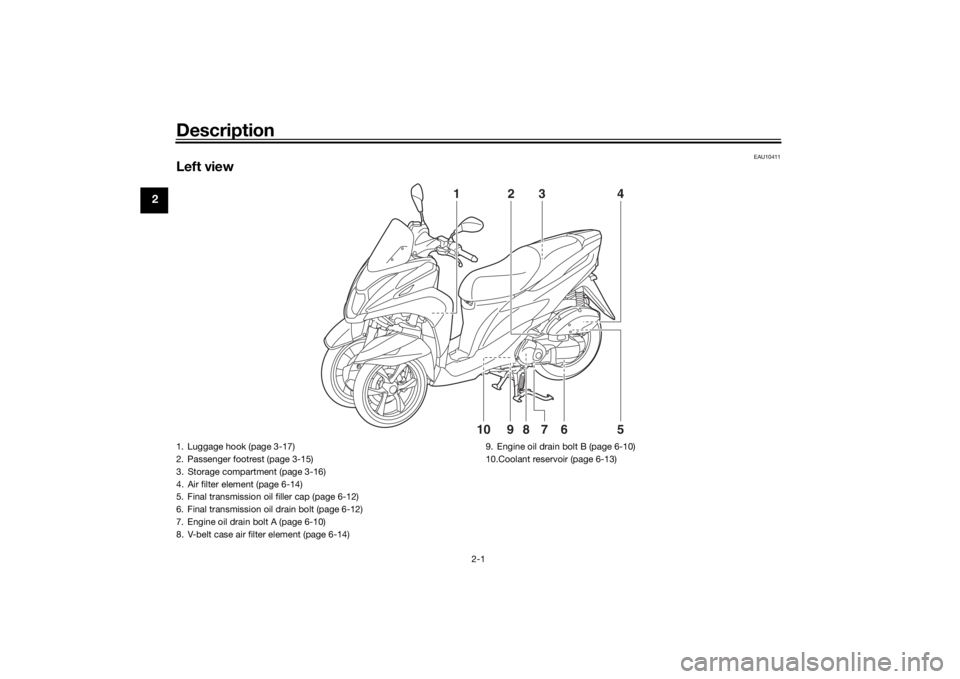
Description
2-1
2
EAU10411
Left view
1
23 45
678910
1. Luggage hook (page 3-17)
2. Passenger footrest (page 3-15)
3. Storage compartment (page 3-16)
4. Air filter element (page 6-14)
5. Final transmission oil filler cap (page 6-12)
6. Final transmission oil drain bolt (page 6-12)
7. Engine oil drain bolt A (page 6-10)
8. V-belt case air filter element (page 6-14) 9. Engine oil drain bolt B (page 6-10)
10.Coolant reservoir (page 6-13)U2CME2E0.book Page 1 Friday, August 21, 2015 9:16 AM
Page 15 of 87
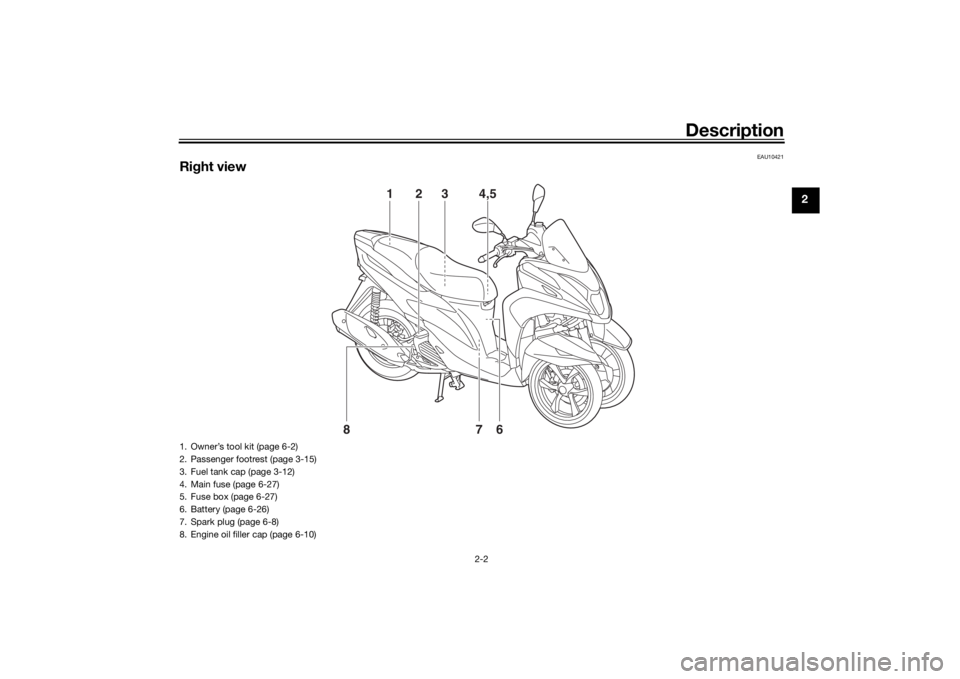
Description
2-2
2
EAU10421
Right view
1
3
4,5
6
2
8
7
1. Owner’s tool kit (page 6-2)
2. Passenger footrest (page 3-15)
3. Fuel tank cap (page 3-12)
4. Main fuse (page 6-27)
5. Fuse box (page 6-27)
6. Battery (page 6-26)
7. Spark plug (page 6-8)
8. Engine oil filler cap (page 6-10)
U2CME2E0.book Page 2 Friday, August 21, 2015 9:16 AM
Page 16 of 87

Description
2-3
2
EAU10431
Controls and instruments
1
9
23 7 8
65
4
1. Rear brake lever (page 3-10)
2. Left handlebar switches (page 3-9)
3. Rear brake fluid reservoir (page 6-20)
4. Multi-function meter unit (page 3-5)
5. Front brake fluid reservoir (page 6-20)
6. Start switch (page 3-9)
7. Front brake lever (page 3-10)
8. Throttle grip (page 6-16) 9. Main switch/steering lock (page 3-1)U2CME2E0.book Page 3 Friday, August 21, 2015 9:16 AM
Page 17 of 87
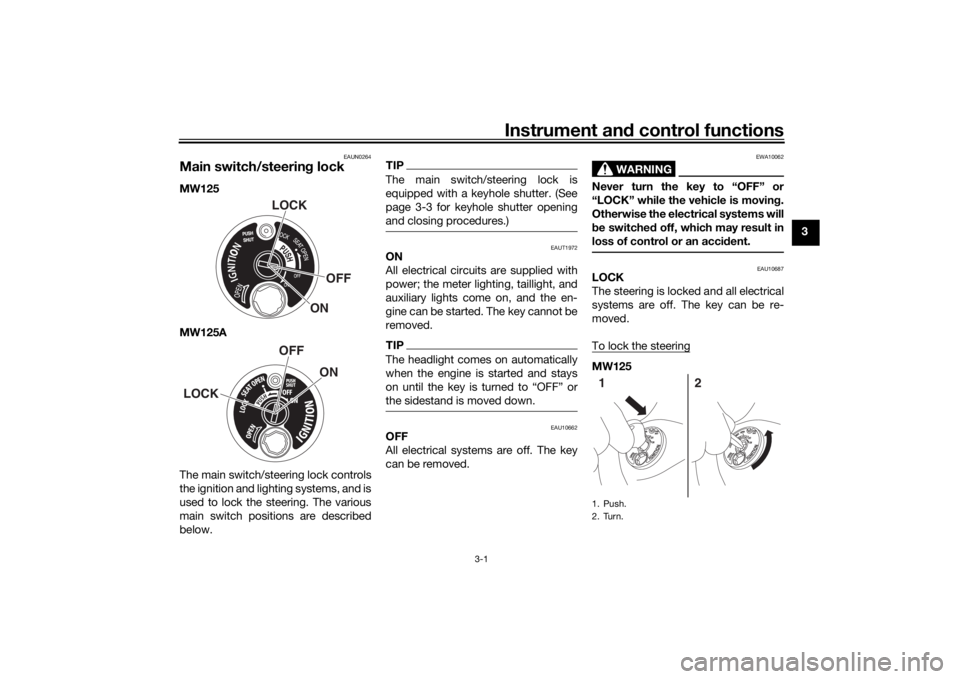
Instrument and control functions
3-1
3
EAUN0264
Main switch/steerin g lockMW125
MW125A
The main switch/steering lock controls
the ignition and lighting systems, and is
used to lock the steering. The various
main switch positions are described
below.
TIPThe main switch/steering lock is
equipped with a keyhole shutter. (See
page 3-3 for keyhole shutter opening
and closing procedures.)
EAUT1972
ON
All electrical circuits are supplied with
power; the meter lighting, taillight, and
auxiliary lights come on, and the en-
gine can be started. The key cannot be
removed.TIPThe headlight comes on automatically
when the engine is started and stays
on until the key is turned to “OFF” or
the sidestand is moved down.
EAU10662
OFF
All electrical systems are off. The key
can be removed.
WARNING
EWA10062
Never turn the key to “OFF” or
“LOCK” while the vehicle is movin g.
Otherwise the electrical systems will
b e switche d off, which may result in
loss of control or an acci dent.
EAU10687
LOCK
The steering is locked and all electrical
systems are off. The key can be re-
moved.
To lock the steeringMW125
LOCK
OFF
ON
LOCK OFF
ON
1. Push.
2. Turn.12
U2CME2E0.book Page 1 Friday, August 21, 2015 9:16 AM
Page 18 of 87
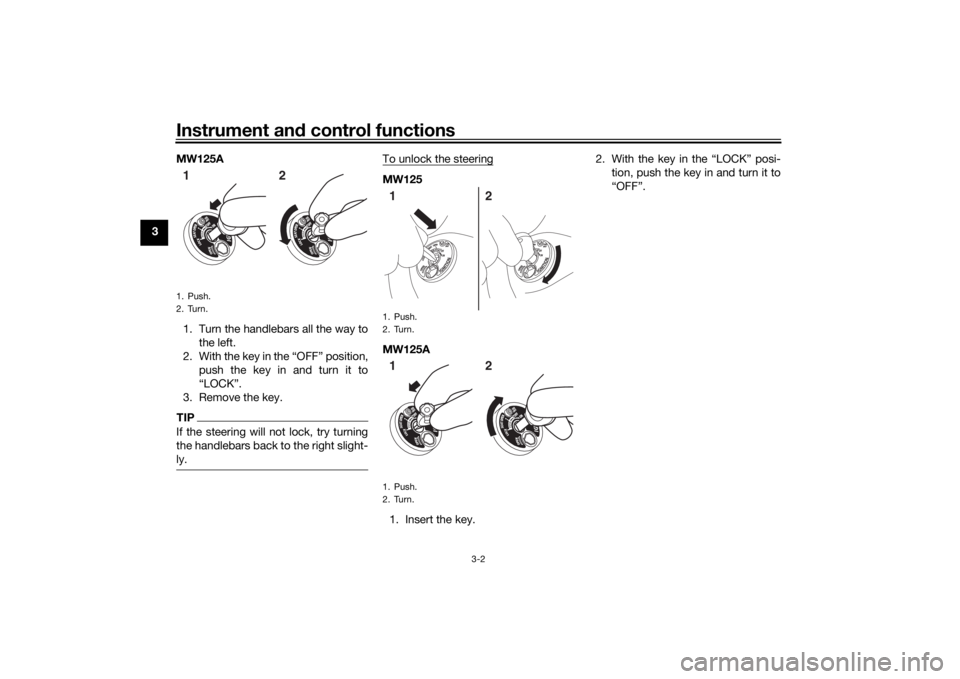
Instrument and control functions
3-2
3 MW125A
1. Turn the handlebars all the way to the left.
2. With the key in the “OFF” position, push the key in and turn it to
“LOCK”.
3. Remove the key.
TIPIf the steering will not lock, try turning
the handlebars back to the right slight-
ly.
To unlock the steeringMW125
MW125A
1. Insert the key. 2. With the key in the “LOCK” posi-
tion, push the key in and turn it to
“OFF”.
1. Push.
2. Turn.12
1. Push.
2. Turn.
1. Push.
2. Turn.1212
U2CME2E0.book Page 2 Friday, August 21, 2015 9:16 AM
Page 19 of 87
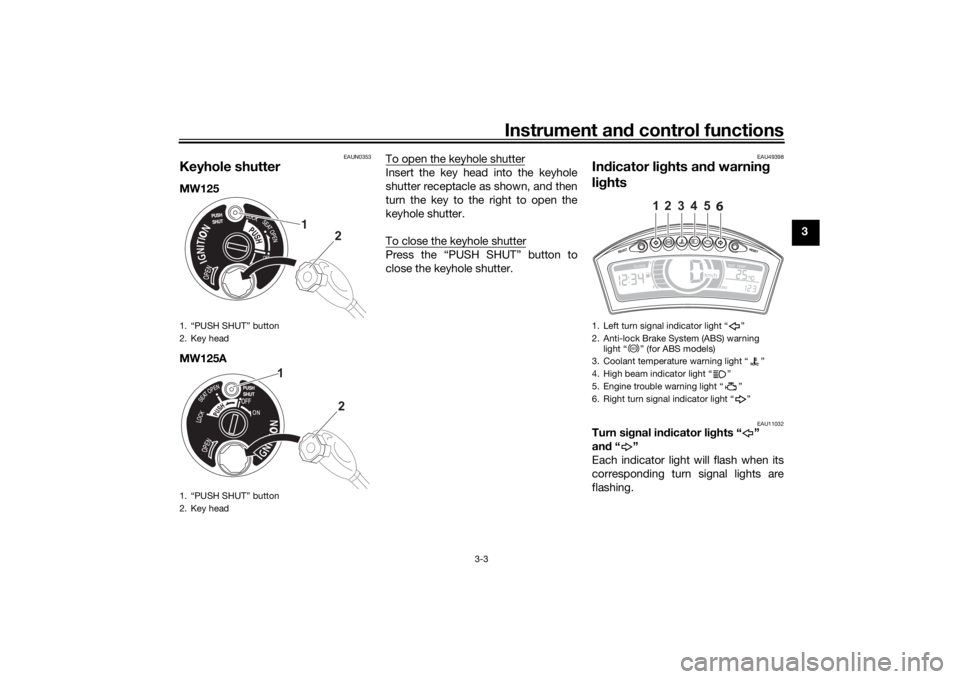
Instrument and control functions
3-3
3
EAUN0353
Keyhole shutterMW125
MW125A To open the keyhole shutter
Insert the key head into the keyhole
shutter receptacle as shown, and then
turn the key to the right to open the
keyhole shutter.
To close the keyhole shutterPress the “PUSH SHUT” button to
close the keyhole shutter.
EAU49398
In
dicator li ghts an d warnin g
lig hts
EAU11032
Turn si gnal in dicator li ghts “ ”
an d“”
Each indicator light will flash when its
corresponding turn signal lights are
flashing.
1. “PUSH SHUT” button
2. Key head
1. “PUSH SHUT” button
2. Key head
1
2
1
2
1. Left turn signal indicator light “ ”
2. Anti-lock Brake System (ABS) warning light “ ” (for ABS models)
3. Coolant temperature warning light “ ”
4. High beam indicator light “ ”
5. Engine trouble warning light “ ”
6. Right turn signal indicator light “ ”
1
2
3
4
5
6
ABS
U2CME2E0.book Page 3 Friday, August 21, 2015 9:16 AM
Page 20 of 87
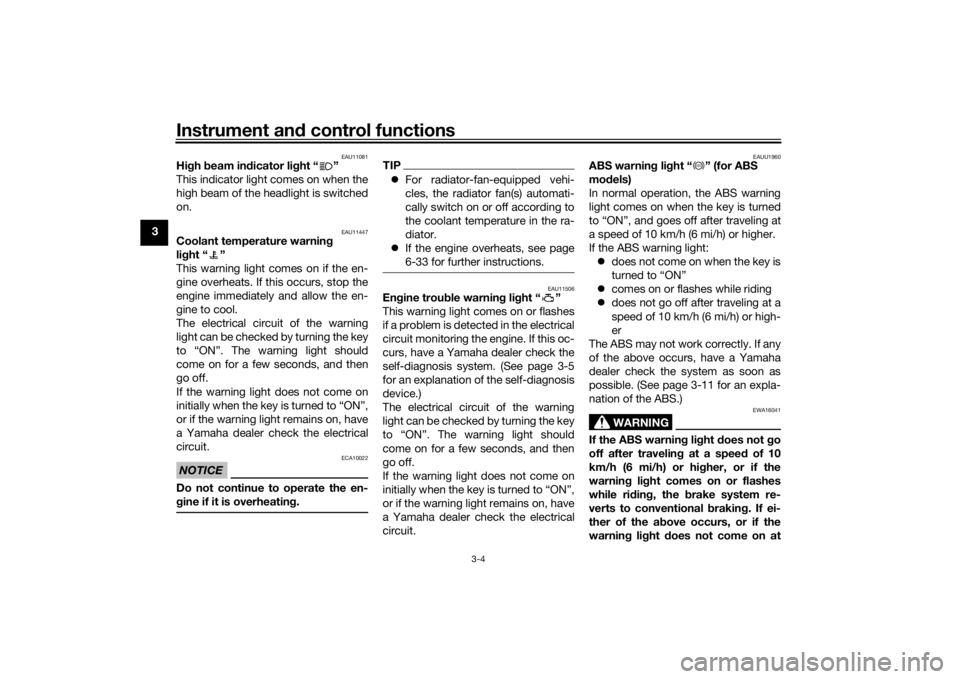
Instrument and control functions
3-4
3
EAU11081
Hi gh beam in dicator li ght “ ”
This indicator light comes on when the
high beam of the headlight is switched
on.
EAU11447
Coolant temperature warnin g
li g ht “ ”
This warning light comes on if the en-
gine overheats. If this occurs, stop the
engine immediately and allow the en-
gine to cool.
The electrical circuit of the warning
light can be checked by turning the key
to “ON”. The warning light should
come on for a few seconds, and then
go off.
If the warning light does not come on
initially when the key is turned to “ON”,
or if the warning light remains on, have
a Yamaha dealer check the electrical
circuit.NOTICE
ECA10022
Do not continue to operate the en-
g ine if it is overheatin g.
TIP For radiator-fan-equipped vehi-
cles, the radiator fan(s) automati-
cally switch on or off according to
the coolant temperature in the ra-
diator.
If the engine overheats, see page
6-33 for further instructions.
EAU11506
Engine trou ble warnin g lig ht “ ”
This warning light comes on or flashes
if a problem is detected in the electrical
circuit monitoring the engine. If this oc-
curs, have a Yamaha dealer check the
self-diagnosis system. (See page 3-5
for an explanation of the self-diagnosis
device.)
The electrical circuit of the warning
light can be checked by turning the key
to “ON”. The warning light should
come on for a few seconds, and then
go off.
If the warning light does not come on
initially when the key is turned to “ON”,
or if the warning light remains on, have
a Yamaha dealer check the electrical
circuit.
EAUU1960
ABS warnin g li ght “ ” (for ABS
mo dels)
In normal operation, the ABS warning
light comes on when the key is turned
to “ON”, and goes off after traveling at
a speed of 10 km/h (6 mi/h) or higher.
If the ABS warning light: does not come on when the key is
turned to “ON”
comes on or flashes while riding
does not go off after traveling at a
speed of 10 km/h (6 mi/h) or high-
er
The ABS may not work correctly. If any
of the above occurs, have a Yamaha
dealer check the system as soon as
possible. (See page 3-11 for an expla-
nation of the ABS.)
WARNING
EWA16041
If the ABS warnin g li ght does not g o
off after travelin g at a speed of 10
km/h (6 mi/h) or hi gher, or if the
warnin g li ght comes on or flashes
while ri din g, the brake system re-
verts to conventional braking . If ei-
ther of the a bove occurs, or if the
warnin g li ght does not come on at
ABS
U2CME2E0.book Page 4 Friday, August 21, 2015 9:16 AM